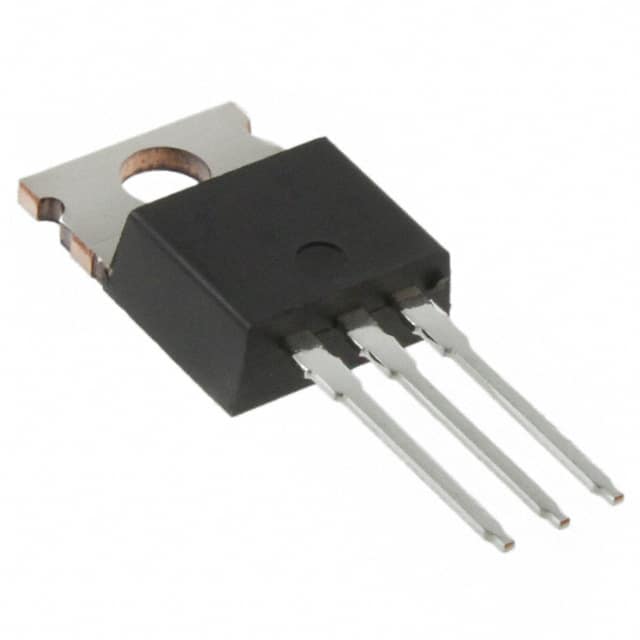Lihat spesifikasi untuk detail produk.

IRFBC40
Introduction
The IRFBC40 is a power MOSFET belonging to the category of electronic components used in various applications. This entry provides an overview of the IRFBC40, including its basic information, specifications, pin configuration, functional features, advantages and disadvantages, working principles, application field plans, and alternative models.
Basic Information Overview
- Category: Power MOSFET
- Use: The IRFBC40 is commonly used as a switching device in power electronics applications.
- Characteristics: It exhibits high voltage capability, low on-resistance, and fast switching speed.
- Package: TO-220AB
- Essence: The essence of the IRFBC40 lies in its ability to efficiently control high power levels in various electronic circuits.
- Packaging/Quantity: Typically packaged in reels or tubes containing multiple units.
Specifications
- Voltage Rating: 600V
- Continuous Drain Current: 4.2A
- On-Resistance: 1.5Ω
- Gate-Source Voltage (Max): ±20V
- Operating Temperature Range: -55°C to 150°C
Detailed Pin Configuration
The IRFBC40 features a standard TO-220AB package with three leads: 1. Gate (G) 2. Drain (D) 3. Source (S)
Functional Features
- High voltage capability
- Low on-resistance
- Fast switching speed
- Enhanced ruggedness and reliability
Advantages and Disadvantages
Advantages
- Suitable for high power applications
- Low conduction losses
- Fast switching performance
Disadvantages
- Gate drive requirements may be more complex compared to lower voltage MOSFETs
- Higher cost compared to some lower voltage alternatives
Working Principles
The IRFBC40 operates based on the principle of field-effect transistors, where the flow of current between the drain and source terminals is controlled by the voltage applied to the gate terminal. When a sufficient voltage is applied to the gate, the MOSFET allows current to flow between the drain and source, effectively acting as a switch.
Detailed Application Field Plans
The IRFBC40 finds extensive use in the following applications: - Switching power supplies - Motor control - Inverters - Audio amplifiers - LED lighting
Detailed and Complete Alternative Models
Some alternative models to the IRFBC40 include: - IRFBC30: Similar characteristics with a lower voltage rating - IRFBC50: Higher voltage rating and current handling capacity - IRFBC20: Lower voltage and current ratings suitable for less demanding applications
In conclusion, the IRFBC40 is a versatile power MOSFET with excellent characteristics suitable for various high-power electronic applications. Its high voltage capability, low on-resistance, and fast switching speed make it a preferred choice in many circuit designs.
Word Count: 411
Sebutkan 10 pertanyaan dan jawaban umum terkait penerapan IRFBC40 dalam solusi teknis
What is the IRFBC40?
- The IRFBC40 is a power MOSFET transistor designed for high-voltage, high-speed power switching applications.
What are the key specifications of the IRFBC40?
- The IRFBC40 has a maximum drain-source voltage of 600V, a continuous drain current of 4.2A, and a low on-resistance.
What are the typical applications of the IRFBC40?
- The IRFBC40 is commonly used in applications such as motor control, power supplies, and DC-DC converters.
What are the advantages of using the IRFBC40 in technical solutions?
- The IRFBC40 offers high voltage capability, fast switching speed, and low on-resistance, making it suitable for efficient power management.
How do I properly drive the IRFBC40 in my circuit?
- It is important to use proper gate drive techniques to ensure reliable and efficient operation of the IRFBC40, including appropriate gate voltage and drive current.
What are the thermal considerations when using the IRFBC40?
- Proper heat sinking and thermal management are essential to ensure the IRFBC40 operates within its specified temperature range for optimal performance and reliability.
Can the IRFBC40 be used in high-frequency applications?
- While the IRFBC40 has fast switching speed, it is important to consider its capacitance and other characteristics when using it in high-frequency applications.
Are there any common failure modes associated with the IRFBC40?
- Common failure modes include overvoltage stress, overcurrent conditions, and excessive junction temperature, so proper protection and control circuits should be implemented.
What are the recommended layout and PCB design considerations for the IRFBC40?
- Proper layout and PCB design, including minimizing parasitic inductance and ensuring good thermal conductivity, are important for maximizing the performance of the IRFBC40.
Where can I find detailed application notes and reference designs for using the IRFBC40?
- Application notes and reference designs for the IRFBC40 can typically be found in the manufacturer's datasheets, application guides, and online resources.

